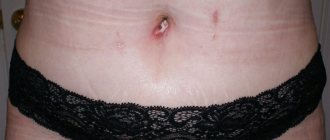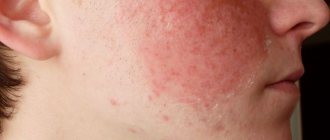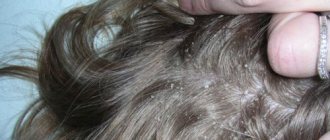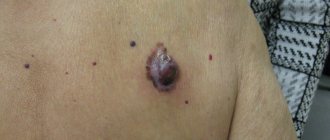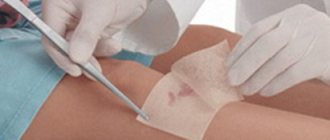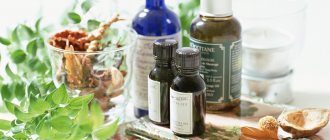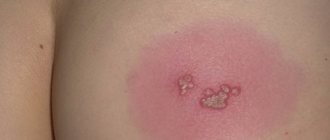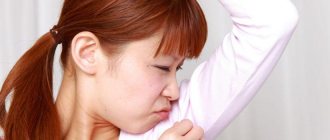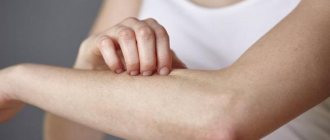Symptoms of fungus under the arms
It is difficult not to notice this illness; it is too obvious even for those patients who are accustomed to not taking their health seriously. Mycotic (fungal) diseases should be treated as quickly as possible, otherwise the spores will spread over a larger area of the skin surface.
Fungus under the armpits (photo of the disease is shown below) appears quite often, since friction often develops in this area of the body. Also, the appearance of mycoses can be facilitated by the use of aggressive deodorants that dry out the skin, wearing synthetic clothing, etc. The armpits are an area of the body to which air access is almost always limited.
How to understand that the appearance of discomfort under the arms is a fungus? In fact, identifying a mycotic infection is quite simple if you know some of the differences in the symptoms of fungal diseases.
- Mycosis (fungus) should be distinguished from lichen. The first is characterized by the appearance of peeling, redness, without swelling and without pain or burning. In some cases, itching may occur and cause discomfort. As a result, the patient scratches the problem area of the skin, after which scratches may remain, which will already cause pain, and purulent discharge may appear. Therefore, if itching occurs, you should use special ointments and refrain from scratching the problem area.
- Atopic dermatitis is not a fungal disease, but many patients, when symptoms appear, confuse this disease with ringworm or a fungus of the skin under the arms. Atopic dermatitis is characterized by the appearance of small ulcers, from which pus or ichor may be released. The area of damaged skin turns red, and small scars may remain after the exacerbation of the disease has passed.
- Linear lichen quite often appears in the skin of the armpits. This disease is characterized by the appearance of pink, purple or brown spots that hurt. The patient experiences a burning sensation, and over time the affected area may grow.
Types of armpit fungus
When you sweat heavily, the armpit becomes a place where dirt, sebum deposits and moisture accumulate. Under these conditions, the skin is easily susceptible to infection. Its main types are lichen and candidal fungus, which accompany itching under the arms.
Ringworm under the arms
This form of fungal infection is similar to a common irritation. But the spots with which it appears have different features. Depending on the type of lichen, they can be:
- Pale pink and arranged in groups in a line (lichen linearis);
- Pink, up to 2 cm in diameter, the appearance of which is preceded by a large maternal spot (pityriasis rosea);
- brown, yellow or pink, up to a centimeter in size, which are located in colonies (pityriasis versicolor).
In all cases, the rash is accompanied by accompanying manifestations in the form of peeling and itching.
Fungus
A special type of infection is Candida; this parasite usually causes thrush in the intimate area. The axillary version of candidiasis is manifested by spots similar to lichen. But the main symptom is a white coating and a violation of the integrity of the upper layer of the skin.
Causes of discomfort
What is the reason for the appearance of fungus under the arms? The photos show an unsightly picture; many patients think that the reasons for the appearance of fungus are insufficient compliance with hygiene rules. This is a misconception: you can take a shower several times a day, but this will not affect the severity of mycotic pathologies.
The following are the most common causes of fungus in the armpits and groin:
- Hormonal surges, as a result of which immunity decreases and the body’s defenses are depleted. Most often this occurs during puberty, and similar hormonal surges are typical for women during menopause.
- With hyperthyroidism and diabetes, fungal spores are often activated, which almost always leads to the development of itching and spots in the armpits. Almost all people with diabetes are familiar firsthand with fungal skin diseases and dermatitis of various etiologies.
- Hereditary predisposition, skin susceptibility to fungal diseases and dermatoses, high allergy.
- Obesity and simply being overweight is an additional factor in the formation of mycotic spots, since sweat and its decomposition products accumulate in the fat folds.
- Stressful situations, chronic fatigue, in which the activity of the sweat glands increases and immunity decreases at the same time - this combination leads to the activation of fungal spores.
- Chronic infectious diseases that slowly but inevitably worsen the immune system.
Prevention
The development of fungus can be prevented by increasing the body’s defenses and following simple hygiene rules:
- Treat all diseases in a timely manner and prevent chronic forms.
- Choose your sex partner carefully.
- Remove hair in the armpit.
- Use deodorants with a safe composition.
- Take a shower every day during the hot season.
- Do not wear synthetic clothing that blocks oxygen access.
- Do not abuse alcohol.
- Take antibiotics strictly as recommended by a specialist.
- Avoid excess weight.
- Take vitamins and probiotics to strengthen your immune system.
- Use a quality razor.
You can prevent the development of mycosis under the arms of a child by following the rules of hygiene and increasing the baby’s immunity.
Not a single professional drug can prevent the development of mycosis if you do not take care of your body. Alcohol, unhealthy diet, and excessive love of coffee, sweets, and spicy foods contribute to the growth of fungi.
Is it possible to become infected through household items and clothing?
There is an opinion that the fungus can be infected through household items: shared bedding, dishes, shoes, clothes, towels. This opinion is only partly true: even if mycotic spores get on the skin of a healthy person, this does not necessarily guarantee the appearance of spots, itching, or peeling.
As mentioned above, spores of mycotic infections can be found on the skin of almost any person. But they are activated only if the body and immunity are so weak that they are unable to stop the process.
Which doctor should I contact?
If a patient suspects lichen or fungal diseases, or if red itchy spots appear in the groin area or armpits, be sure to make an appointment with a dermatologist for diagnosis. It is important to determine what the cause of the disease is - lichen, candida or a fungus of another origin.
Dermatologists are admitted free of charge; if you have a medical policy, all costs will be borne by the Insurance Company. If the patient wants to undergo an examination anonymously, he can contact a paid diagnostic center.
Classification and stages
There are several forms of axillary hidradenitis:
- Acute purulent form. The pathology develops due to blockage of the apocrine sweat and sebaceous glands. Among patients with this form of the disease are people who do not take good care of their armpits. Hidradenitis in this form occurs as a typical inflammation in the body: low-grade fever, sometimes rising to 38 degrees, malaise, discomfort, developing into pain in the armpits. The purulent form is life-threatening for the patient if he does not seek treatment from a doctor.
- If you take sufficient care of your armpits, but do not shave carefully, the delicate skin of this area may become injured. Staphylococcal or other types of pathogenic microflora get into scratches and wounds. Hidradenitis nodosa begins to form, tending to develop into purulent if left untreated.
- Chronic hidradenitis is more often called a recurrent form, which is characterized by a purulent process that lasts a long time. The disease often appears at regular intervals with an acute purulent phase. The area of apocrine glands affected by inflammation increases. Lack of treatment for purulent processes is dangerous due to septic consequences, threatening the life of the patient.
Like hidradenitis inguinalis, axillary develops through stages over 10 days. The first stage is observed during the formation of nodular formations of dense consistency.
Modern diagnostic methods
As a rule, to determine the type of fungus, it is enough to take a scraping from the affected area. Experienced doctors sometimes only need to conduct a visual examination and listen to the patient’s complaints in order to accurately determine the cause of the pathology.
The sooner treatment begins, the greater the chance that it will be successful and the fungus will not spread to large areas of the skin. In some cases, if chronic diseases of internal organs are suspected, a dermatologist may also refer the patient to undergo a general or biochemical blood test. This is required in order to identify the underlying disease (perhaps the patient has diabetes, problems with hormones, liver or pancreas diseases) - and treat it, which will have a positive effect on the condition of the skin.
Review of treatment methods for armpit fungus
There are several main areas of therapy. How to get rid of armpit fungus for a long time, while avoiding relapses of the disease? It is optimal to use the following treatment methods in combination:
- external (ointments, creams, balms);
- internal (taking pills and antifungal drugs);
- vitamin and mineral therapy.
If you use only one method (for example, ointment), the fungus under the armpit may take a long time to resolve, and then the patient will suffer from a relapse of the disease. Therefore, it is optimal to use several methods of therapy at once - for example, combining the use of ointments with taking tablets. This treatment will achieve maximum effect and relieve the patient from the disease.
Causes of the disease
The main cause of the disease is a decrease in immunity, which is why active growth of fungi begins. However, other factors may also influence the development of the pathological process:
- failure to comply with personal hygiene rules;
- hormonal imbalance;
- treatment with glucocorticosteroids;
- increased sweating;
- viral and bacterial infections;
- improper hair removal;
- long-term antibacterial therapy;
- inflammatory processes in the body;
- wearing clothes made of synthetic materials;
- work in dusty and dirty rooms;
- abuse of strong alcoholic drinks;
- stressful situations;
- hereditary predisposition.
Important!
Overweight people most often suffer from fungus, since moisture accumulates in the formed folds - this creates favorable conditions for the proliferation of pathogenic microorganisms.
Creams and ointments with antimycotic action
How to cure armpit fungus if the disease brings constant discomfort and itching? You cannot do without using ointments for external use; here is a list of the most effective:
- "Clotrimazole" is available in the form of gel, cream and ointment (each product has a different concentration of the active substance). The main component is an antimycotic substance called clotrimazole. The product should be applied in a thin layer to the affected area twice a day. Reviews about the ointment are the most positive: patients note an improvement in their condition after just a few days of use.
- Lamisil is available in the form of a spray and ointment. The main active ingredient is terbinafine. There is a cheaper analogue, which is called “Terbinafine”, but, as a rule, it is not available in pharmacies.
- "Fugnoterbin" is an effective ointment that is active against almost any type of fungus.
- "Mikonorm" is an ointment that reduces the severity of itching after the first use. The main active ingredient is also terbinafine hydrochloride.
- Terbizil is another popular ointment that is effective against almost any type of fungal pathology.
How to treat?
Treatment of mycosis of the armpits is carried out with the help of medications, folk remedies, injections, antiperspirants and laser.
Medicines
To stop the growth of pathogenic microorganisms, the patient is prescribed medications in tablet form:
- Ketoconazole is a powerful drug with fungicidal and fungistatic effects.
- Itraconazole is a triazole derivative that inhibits protein synthesis and prevents the formation of new spores.
- Fluconazole is a drug to block the growth of fungi and eliminate unpleasant symptoms.
Injections, antiperspirants and laser
To regulate sweating, the doctor may prescribe injections of Dysport and Botox - they block the nerve impulse that provides communication between the sweat glands and the autonomic center. As a result, the intensity of sweating decreases. The effect of the drugs is temporary - only 10-12 months.
Conventional antiperspirants are ineffective for hyperhidrosis, so it is better to use long-acting products instead - they are non-toxic and guarantee complete dryness for two days. Antiperspirants do not interfere with the functioning of the sweat glands , but only normalize their work.
Laser treatment is to get rid of excessive sweating and further development of fungal infection. During the procedure, a micropuncture is made in the skin - an optical fiber is inserted through it. Under the influence of the laser, the sweat glands are destroyed, after which they regress naturally.
Ointments
Treatment of fungal diseases is impossible without the use of ointments for application to infected skin.
To eliminate visible manifestations of mycosis, the following drugs are recommended:
- Lamisil is a drug that has a wide spectrum of antifungal activity.
- Terbinafine is an antimycotic agent of the allylamine group, which has a detrimental effect on fungi.
- Myconorm is a medicine whose active components destroy pathogenic microflora.
ethnoscience
Folk remedies are quite effective in treating mycosis of the armpits, but they only help eliminate the symptomatic manifestations of the disease and do not stop the growth and development of fungi.
The use of alternative medicine recipes is rational only if the medications prescribed by a dermatologist are used.
Painful symptoms are relieved by products intended for treating affected areas of the skin:
- water tincture of propolis;
- calendula tincture mixed with water in equal proportions;
- tar soap;
- soda solution;
- apple cider vinegar mixed with water.
Important!
In people with a predisposition to allergies, folk remedies can cause an undesirable reaction.
Tablets with antimycotic action
How to treat armpit fungus so that it doesn’t come back again? Most often, getting rid of the visible manifestations of the disease is quite simple, but preventing a relapse is more difficult. Dermatologists recommend combining both internal and external methods of therapy. To do this, you should take a course of tablets in parallel with the use of creams and ointments.
- Fluconazole is probably the cheapest and most popular remedy against the manifestations of candidiasis and many other fungal pathologies. Before starting use, you should consult a dermatologist.
- Itraconazole is a tablet drug that kills almost all types of spores. It has contraindications for use, side effects are possible, so before starting use you should consult a dermatologist.
Features of the treatment of fungal infection in a nursing mother
The lactation period and the accompanying hormonal imbalance often contribute to the occurrence of mycosis, which is why many young mothers are faced with a choice: start treatment or try to maintain breastfeeding.
A fungal infection, like potent drugs, can harm the baby, so experts offer laser treatment . This method is absolutely safe for both mother and baby, which means that there is no need to stop lactation.
Vitamin and mineral complexes for skin
As mentioned above, fungal skin lesions should be treated comprehensively. Taking vitamin-mineral complexes is a simple way to avoid deficiencies of vital microelements. Below is a list of complexes, the use of which will allow you to achieve the fastest possible healing of the skin and return it to its original form:
- "Perfectil" contains minerals, vitamins, as well as plant extracts, the presence of which in the composition contributes to the rapid restoration of the epidermis. While taking it, immunity will increase and hair loss will stop (due to the zinc content in the composition).
- “Brewer's Yeast Esvitsin” contains faith and a full complex of B vitamins, due to which it can quickly restore the skin.
- "Pantovigar" - vitamins containing brewer's yeast, promote regeneration and improve the protective properties of the epidermis.
Clinical picture
The disease develops in accordance with the symptoms indicated in the stages of pathology. Common to all inflammatory processes is an increase in temperature, which in some cases fluctuates within subfebrile limits, but sometimes can rise to 38 degrees.
An increase in temperature turns out to be the beginning of a chain reaction of inflammation, when this symptom is followed by a feeling of fatigue, dizziness, headaches, and chills.
A characteristic sign of hidradenitis, which allows it to be differentiated from other pathologies, is the absence of necrotic rods. Due to a sufficient amount of subcutaneous fat in the lesion bordering the armpit, the inflammatory process can spread to the subcutaneous tissue, causing a disease - phlegmon.
When lymph nodes are found in the affected area, lymphadenitis may be detected.
The chronic form of hidradenitis often reveals pathological nodes of different stages of development.
Traditional methods of treating fungus
Traditional methods of combating armpit fungus are still popular:
- Affected areas of the skin can be wiped with a decoction of calendula and oak bark. Infusions of these herbs have an astringent and drying effect. For a glass of boiling water, take a tablespoon of the dry mixture, leave for a couple of hours and wipe the affected areas with a cotton pad soaked in the infusion.
- A decoction based on common burdock and chamomile flowers. You will need 50 g of dried flowers, 50 g of fresh burdock and 500 ml of water. Boil for 30-40 minutes over low heat. Then let it cool, strain and lubricate the skin where the lichen appeared.
ethnoscience
To combat mycosis of the armpits, traditional methods are used.
It is important to remember that only a healthy body can overcome fungus on the skin. Cream for armpit fungus, tablets and sprays will not be able to cure it if the immune system is suppressed.
However, it should be remembered that they are not capable of completely replacing drug therapy.
- Calendula tincture diluted in water (1:1). Used daily 3 times a day.
- Water mixed in equal quantities with apple cider vinegar is applied to the fungus-affected area 2 times a day.
- Treat the skin under the arms with baking soda, diluted equally in water. The product is left for 5 minutes, then washed off. The procedure is carried out in the morning and evening.
- Lemon juice is applied to cracks and abrasions.
- Every day the skin under the arms is treated with tar soap.
Decoctions of oak bark, sage, and chamomile infusion mixed with soda (in equal quantities) are effective against fungus. Frequency of treatment – 3 times a day.
How to prevent relapse of pathology?
In order to prevent the recurrence of symptoms of fungus under the arms, you should undergo a full examination, stop chronic diseases of the internal organs, give up bad habits, and switch to proper nutrition. This set of measures will help strengthen the immune system, as a result of which fungal spores simply do not become active.
If the patient has diabetes, it is recommended to adhere to a special low-carbohydrate diet and not stop taking medications (if necessary, insulin injections). If you maintain the sugar level at an acceptable level, the fungus will not bother the patient.
